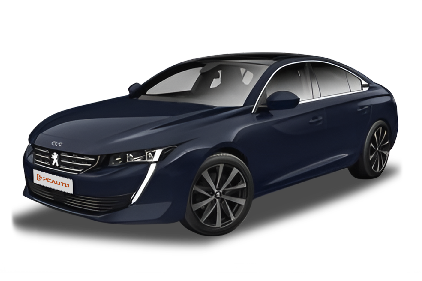Q
Which Peugeot 508 is the best?
In the Malaysian market, the most recommended model in the Peugeot 508 series is the Peugeot 508 GT. It is equipped with a 1.6-liter turbocharged engine paired with an 8-speed automatic transmission, offering a powerful 225 horsepower while also taking fuel economy into account, which is suitable for local driving needs. This car features Peugeot's latest i-Cockpit cabin design, with a 12.3-inch digital instrument panel and a 10-inch central touchscreen, full of a sense of technology. It also comes standard with a rich set of safety features such as adaptive cruise control, lane keeping, and automatic emergency braking. For consumers who pursue a sporty style, the 508 GT Line is also a good choice. It retains most of the configurations of the GT version, but with slightly lower power and a more affordable price. It's worth mentioning that the Peugeot 508 series has a suspension tuning that leans towards comfort, making it very suitable for Malaysian road conditions. Meanwhile, its unique design language also makes it stand out among cars in the same class. If you pay more attention to environmental protection, you can also keep an eye on the plug-in hybrid versions that Peugeot may introduce in the future. Such models will perform better in terms of fuel economy. No matter which 508 model you choose, it is recommended to take a test drive at a local authorized dealer to experience the unique charm of French cars firsthand.
Special Disclaimer: This content is published by users and does not represent the views or position of PCauto.
Related Q&A
Q
How many cylinders is a Peugeot 508?
Sorry, I haven't found the specific information about the number of cylinders of the Peugeot 508. Generally speaking, for D-class sedans like the Peugeot 508, the engines commonly equipped usually have 4 cylinders. A 4-cylinder engine can strike a good balance between power and fuel economy, meeting the needs of daily driving and certain power requirements. If the vehicle is equipped with turbocharging technology, it can also improve the power output to a certain extent. However, to know the exact number of cylinders of the Peugeot 508, it is recommended to check the vehicle's official manual or consult an authorized Peugeot dealer, as they can provide accurate and detailed technical parameter information about this vehicle.
Q
Is the Peugeot 508 a big car?
The Peugeot 508 belongs to the mid-sized sedan category (D-segment) in the Malaysian market. Its body dimensions are 4.75 meters in length, 1.86 meters in width, and 1.42 meters in height, with a wheelbase of 2.79 meters. Compared with traditional Class B sedans like the Honda Accord or Toyota Camry, it's slightly shorter in wheelbase but similar in width, and it's a European mid-sized car with a more sporty design. Although its fastback styling sacrifices some rear-seat headroom, the trunk volume reaches 487 liters. Paired with frameless doors and a low roofline, it looks more sleek and dynamic visually.
In the Malaysian road environment, the size of the 508 is suitable for city driving. It has better maneuverability in narrow alleys than real large-sized sedans (E-segment), yet still offers excellent stability on the highway. Competitors in the same class, such as the Volkswagen Passat or Mazda 6, have similar dimensions. However, the 508 improves space utilization through its i-Cockpit design. The driver's seat visibility and storage compartment layout are more suitable for Asian body types.
It should be noted that Malaysian consumers who often need to carry five adults on long-distance trips are advised to actually experience the rear-seat knee room. After all, European models focus more on the front-seat driving and riding experience. The handling flexibility of the 508 will show its advantages in the old cities of Penang or Kuala Lumpur. Meanwhile, its active safety systems like lane-keeping can also adapt to the complex road conditions in Malaysia.
Q
Is the Peugeot 508 petrol?
Yes, the Peugeot 508 is available with a gasoline engine version in the Malaysian market. Specifically, it is equipped with a 1.6-liter PureTech turbocharged gasoline engine. This engine is well-known for its high efficiency and low emissions. It can deliver a maximum output power of up to 165 horsepower and is paired with an 8-speed automatic transmission, offering a smooth driving experience.
As a mid-sized sedan, the Peugeot 508 not only focuses on power performance but also features a stylish exterior design and luxurious interior configuration. It is suitable for Malaysian consumers who pursue driving pleasure and comfort. Moreover, the 508 is also equipped with advanced driving assistance systems, such as adaptive cruise control and lane - keeping assist, which enhance driving safety.
In Malaysia, gasoline-powered cars remain the mainstream choice because of the well-developed gas station network and relatively stable gasoline prices. The gasoline version of the Peugeot 508 precisely meets this market demand. Meanwhile, its engine technology also complies with the current environmental protection trend, making it suitable for daily commuting and long-distance driving.
Q
How to charge a Peugeot 508?
Charging the electric Peugeot 508 (like the plug-in hybrid 508 Hybrid) is a breeze. First, make sure to park your vehicle in a safe and well-ventilated area. Then, use the charging cable that comes with the car. Plug one end into the vehicle's charging port (usually located at the rear side of the car body) and the other end into a household power supply (220V) or a public charging station. While charging, the dashboard will show the charging status and the estimated time to finish. It's recommended to use a dedicated charging station to boost efficiency and protect the battery life.
In Malaysia, the network of public charging stations is gradually improving. You can find nearby charging points through local platforms such as ChargeNation or JomCharge. Also, it's a good idea to regularly check if the charging equipment is in good condition and avoid using damaged cables. If you choose the fast-charging mode, it takes about 2 hours to reach 80% charge. However, long-term use of fast charging may affect the battery health, so it's better to rely on slow charging in daily use.
Moreover, Peugeot's battery management system can optimize the charging efficiency. Owners don't need to worry too much about over-charging. But pulling out the plug in time after charging can save energy. As for the fuel-powered Peugeot 508, you need to refill gasoline at a gas station, which has nothing to do with charging.
No matter which powertrain system your Peugeot 508 has, regular maintenance can ensure the best performance of the vehicle.
Q
Are Peugeot 508 expensive to insure?
In Malaysia, the insurance costs for the Peugeot 508 are generally slightly higher than those of ordinary Japanese or domestic models. This is mainly due to its positioning as a European mid-sized sedan, higher maintenance costs, and a relatively large proportion of imported parts. However, the specific insurance premiums still depend on the vehicle's age, engine specifications (such as 1.6T or plug-in hybrid versions), the owner's driving record, and the insurance company's policies. It is recommended that car owners compare quotes from different insurance companies before purchasing insurance and consider adding third-party fire and theft insurance for comprehensive protection.
In addition, the maintenance network for European cars in Malaysia is relatively limited, which may affect insurance assessments. But the Peugeot officially authorized maintenance centers can provide original parts and professional services, which helps to reduce the long-term maintenance risks. If the budget is limited, car owners can choose a higher excess to lower the insurance premiums. At the same time, regular vehicle maintenance to keep the car in good condition can also indirectly reduce insurance costs. The insurance costs of other European cars with similar positioning, such as the Volkswagen Passat or Skoda Superb, are also at a similar level. Car owners can make a comprehensive trade-off based on their personal needs.
Q
What is the fuel consumption of Peugeot 508?
The fuel consumption performance of the Peugeot 508 varies depending on the model and powertrain configuration. Take the 1.6-liter PureTech turbocharged gasoline engine version commonly seen in the Malaysian market as an example. Its combined fuel consumption is approximately 6.0 to 6.5 liters per 100 kilometers. The 2.0-liter BlueHDi diesel engine version is even more fuel-efficient, with a combined fuel consumption of 4.5 to 5.0 liters per 100 kilometers. The specific figures are also affected by factors such as driving habits, road conditions, and vehicle load. For Malaysian consumers, choosing the diesel version may offer better fuel economy during long-distance driving, while the gasoline version is more suitable for urban commuting. It's worth mentioning that the Peugeot 508 adopts advanced engine technology and lightweight design, which not only improves fuel efficiency but also reduces emissions, meeting the current environmental protection trend. If you're particularly concerned about fuel consumption, it's recommended to maintain smooth acceleration and deceleration during actual driving and regularly service your vehicle, such as checking tire pressure and replacing the air filter. These small tips can help further optimize fuel consumption performance.
Q
Is the Peugeot 508 electric?
Currently, the Peugeot 508 available in the Malaysian market is the traditional fuel-powered version, which includes a 1.6-liter turbocharged gasoline engine option. There is no all-electric vehicle model yet. However, Peugeot's parent company, the Stellantis Group, is actively promoting an electrification strategy. Electric vehicle models such as the e-208 and e-2008 have been launched in overseas markets, and it's expected that the 508 series will also get an electrified version in the future.
For Malaysian consumers, if they're considering European new energy vehicles, they can pay attention to all-electric models like the locally introduced BMW i4 and Mercedes-Benz EQE, or wait for Peugeot's future electric products in the Southeast Asian market. The Malaysian government encourages the popularization of electric vehicles through tax - exemption policies, but the charging infrastructure is still under construction. It's recommended to evaluate daily usage scenarios before buying a car. If short-distance commuting is the main need, plug-in hybrid models like the Peugeot 3008 PHEV can also be considered, which combines the convenience of fuel with partial all-electric driving capabilities.
Q
How many cc is a Peugeot 508?
The Peugeot 508 offers a variety of engine options in the Malaysian market. The specific engine displacement depends on the model year and version. Currently, the common petrol version is equipped with a 1.6-litre PureTech turbocharged engine with an actual displacement of 1,598 cc, which can output approximately 180 horsepower. The diesel version, on the other hand, is fitted with a 2.0-litre BlueHDi engine with a displacement of 1,997 cc, offering around 180 horsepower. In addition, Peugeot 508 also has a plug-in hybrid version, which combines a 1.6-litre petrol engine and an electric motor, with a combined system power of up to 225 horsepower.
For Malaysian consumers, when choosing a car's engine displacement, they need to consider their daily usage requirements. A small-displacement turbocharged engine is suitable for urban commuting, taking into account fuel economy. A larger displacement engine is more suitable for long-distance driving or for those who pursue better power performance. The diverse power configurations of the 508 can meet different driving preferences.
Meanwhile, Malaysia's road tax system is graded based on engine displacement. It is recommended to understand in detail the road tax costs corresponding to each displacement before buying a car, so as to make a more cost-effective choice.
Q
What kind of engine is in the Peugeot 508?
The Peugeot 508 offers a variety of powertrain options in the Malaysian market, including efficient petrol and diesel engine versions. The petrol engine is mainly a 1.6-liter PureTech turbocharged engine, which delivers 180 horsepower and 250 Nm of torque. It's paired with an 8-speed automatic transmission, balancing power and fuel economy. The diesel version, on the other hand, is equipped with a 2.0-liter BlueHDi engine, which has stronger torque output and is suitable for long-distance driving.
In addition, the Peugeot 508 also offers a plug - in hybrid electric vehicle (PHEV) version. It combines a 1.6-liter petrol engine with an electric motor, with a combined output of up to 225 horsepower. It has an all-electric range of about 50 kilometers, making it a great choice for environmentally-conscious consumers.
Peugeot's engine technology focuses on low emissions and high efficiency, meeting the global environmental protection trend. Meanwhile, its driving experience leans towards comfort and precise handling, which is suitable for the diverse road conditions in Malaysia.
For readers who want to know more about engine technology, they can focus on how turbocharging and hybrid systems enhance performance and energy-saving. These technologies are becoming more and more popular in the current automotive industry.
Q
Does a Peugeot 508 have a timing belt or chain?
The Peugeot 508 has adopted different timing drive designs according to different years and engine models. The early 1.6-liter and 2.0-liter diesel engine versions usually use a timing belt, while the 1.6-liter THP gasoline engine versions launched in recent years have switched to a timing chain. These two designs each have their own advantages and disadvantages. The timing belt has a lower cost but needs to be replaced regularly (usually every 60,000 to 100,000 kilometers). On the other hand, the timing chain is more durable and basically maintenance-free, but it may be a bit noisier. Malaysian car owners should refer to the vehicle manual or consult an authorized service center to confirm the specific configuration of their vehicles. By the way, I'd like to remind everyone that regular inspections are very important regardless of which timing system is used, because once a failure occurs, it may cause serious damage to the engine. Additionally, in the hot and humid climate of Malaysia, the rubber timing belt will age faster, so it's even more necessary to strictly follow the maintenance schedule for inspections and replacements.
Latest Q&A
Q
How much will 2025 Tucson cost?
The exact pricing for the 2025 Tucson hasn’t been announced yet, but based on the current model’s price range and its positioning in the compact SUV segment, we expect a starting price between RM140,000 and RM180,000. Final figures will vary depending on trim levels and optional extras.
The new model is likely to feature upgraded driver-assist tech, including more advanced lane-keeping and adaptive cruise control. Inside, we could see improved materials, a larger infotainment screen, and added convenience features like wireless charging.
With the compact SUV market getting more competitive, brands are packing in better tech while keeping prices sharp. If you’re interested, keep an eye out for official updates or check with local dealers for the latest offers. It’s also worth comparing specs and pricing against rivals to make the right choice.
Q
Will the Hyundai Tucson change in 2025?
Based on current information, the 2025 Hyundai Tucson is expected to receive several updates, likely including subtle exterior styling tweaks, interior upgrades, and enhanced tech features—such as a more advanced infotainment system or driver-assistance technologies. However, official details are still pending.
Hyundai typically refines design language and boosts tech offerings during mid-cycle updates, so the new Tucson may feature sharper lighting signatures or a larger touchscreen while retaining existing powertrain options, including gasoline and hybrid variants.
For buyers prioritizing practicality and technology, the Tucson has always been a solid value proposition in its class, offering spacious interiors and generous standard features that cater well to families. The refreshed model could further strengthen these strengths.
If you're considering a purchase, keep an eye out for official updates later this year to confirm specs and launch timing. It’s also worth cross-shopping rivals in the segment to ensure you’re choosing the right SUV for your needs.
Q
What is the resale value of a 2018 CLA?
**2018 Mercedes-Benz CLA Used Value Guide**
The resale value of a 2018 CLA depends on factors like condition, mileage, specs, and service history, typically ranging between RM100k to RM150k—exact pricing requires an in-person inspection. Thanks to the Mercedes badge and its coupe-like styling, the CLA holds decent demand in the used market, especially low-mileage examples with full maintenance records.
Key factors affecting price:
- Complete service history (dealer stamps preferred)
- Remaining factory warranty
- Exterior color (popular shades like black/white may command slightly more)
- AMG Line or higher trims can add 5-10% over base models
Note: Luxury cars take the biggest depreciation hit in the first 3 years, but the CLA (being an entry-level model) retains value better than most. Before selling, get a professional inspection and organize all receipts—it helps justify your asking price.
For reference, check comparable Audi A3 or BMW 2 Series listings, though the CLA’s frameless doors and brand appeal often give it a slight edge. For the most accurate valuation, review recent transactions on local used car platforms or visit an official Mercedes-Benz Certified Pre-Owned dealer.
Q
How much is a 2018 CLA 250 worth?
Here's a natural-sounding translation from an automotive editor's perspective:
"The 2018 CLA 250 currently holds a market value of around RM150k to RM180k, depending on factors like condition, mileage, specs, and service history. Well-maintained models with low mileage can fetch prices near the top end, while those with visible wear or accident records may drop significantly.
As Mercedes-Benz’s entry-level coupe, the CLA 250 packs a 2.0L turbocharged engine delivering 208hp and 350Nm of torque, paired with a 7-speed dual-clutch transmission. It offers sharp handling and lively performance—ideal for drivers who enjoy a sporty feel.
Inside, you’ll find a refined cabin with standard features like a multimedia system and reversing camera. Higher-spec variants might add extras like a sunroof or premium audio.
If you’re shopping for a used unit, always check maintenance records and get a professional inspection on critical components (engine, gearbox, etc.). For context, cross-shop rivals like the A 250 or BMW 2 Series from the same year to weigh your options thoroughly."
(Note: Adjusted "RM" placement for natural flow and trimmed some redundant phrasing while keeping the technical details and conversational tone.)
Q
What is the maintenance cost for a 2018 CLA?
**Maintenance Costs for the 2018 CLA**
The maintenance costs for a 2018 CLA can vary depending on the vehicle’s condition, mileage, and the services required. A standard service typically includes basic items like an oil and filter change, which may cost between RM 800 to RM 1,500—depending on the type of oil used and whether you go to an authorized dealer or a third-party workshop.
If additional services are needed, such as brake fluid replacement, air filter changes, or tire rotation, the cost could go up to around RM 2,000 to RM 3,000. To keep the car running smoothly, it’s recommended to service the CLA every 10,000 km or 12 months, whichever comes first.
As a luxury model, the CLA’s parts and labor costs may be slightly higher than mainstream brands. However, sticking to regular maintenance helps extend the car’s lifespan and prevents costly repairs down the road. To save on expenses, owners can consider prepaid service packages or reputable independent workshops. Just make sure to keep full service records—it’ll help maintain the car’s resale value.
View More

















Pros
Cons